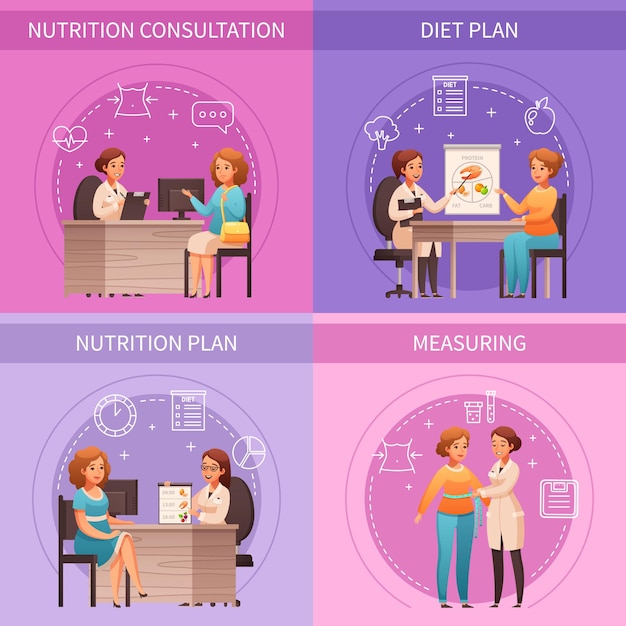WIC Program: Updated Guidelines for Nutritional Support

The WIC (Women, Infants, and Children) Program provides federal grants to states for supplemental foods, healthcare referrals, and nutrition education for low-income pregnant, breastfeeding, and non-breastfeeding postpartum women, and to infants and children up to age five who are found to be at nutritional risk.
The **WIC Program: Nutritional Support for Women, Infants, and Children – Updated Guidelines** ensures that vulnerable populations receive the necessary resources for healthy development. This article dives into the specifics of the WIC program, highlights key updates to its nutritional guidelines, and explains how these changes aim to better serve participants.
Understanding the WIC Program: A Comprehensive Overview
The WIC Program is a federal assistance initiative dedicated to safeguarding the health of low-income women, infants, and children up to five years old who are at nutritional risk. Let’s delve into the program’s objectives, eligibility criteria, and the range of services it provides.
Established in 1974, WIC aims to improve the health outcomes of its participants by providing supplemental foods, nutrition education, and referrals to healthcare and other social services. It operates through state health departments and local agencies, ensuring services are accessible at the community level.
Key Objectives of the WIC Program
The WIC program has several core objectives designed to enhance the well-being of participants. These include:
- Improving the dietary intake of participants by providing nutritious foods.
- Promoting and supporting breastfeeding among new mothers.
- Educating participants about nutrition and healthy lifestyles.
- Referring participants to healthcare and other social services, such as Medicaid and food stamps.
Eligibility and How to Apply
To be eligible for WIC, applicants must meet specific criteria related to income, residency, and nutritional risk. Understanding these requirements is the first step in accessing the program’s benefits.
- Income Requirements: Applicants must have an income at or below a level specified by each state agency, which is typically at or below 185% of the U.S. Poverty Income Guidelines.
- Residency: Applicants must reside in the state where they are applying.
- Nutritional Risk: Applicants must be determined to be at nutritional risk by a healthcare professional, such as a doctor, nutritionist, or nurse.
Applying for WIC involves contacting the local WIC agency, attending an eligibility determination appointment, and providing documentation such as proof of income, residency, and identity. The application process is designed to be straightforward to ensure those in need can access the program’s benefits without unnecessary hurdles.
In summary, the WIC Program plays a vital role in ensuring the health and nutritional well-being of vulnerable populations, offering comprehensive support to women, infants, and children at nutritional risk.
Recent Updates to WIC Nutritional Guidelines: What’s New?
The WIC program periodically updates its nutritional guidelines to reflect the latest scientific evidence and dietary recommendations. Understanding these updates is crucial for both participants and healthcare providers to maximize health benefits.
The latest update to the **WIC Program: Nutritional Support for Women, Infants, and Children – Updated Guidelines** includes changes to food packages, breastfeeding support, and strategies for addressing specific nutritional deficiencies.

Changes to Food Packages
Food packages are a central component of the WIC program, providing participants with specific foods tailored to their nutritional needs. Recent updates have introduced several changes to these packages.
- Increased variety and flexibility in food choices, allowing participants to select foods that align with their cultural preferences and dietary needs.
- Greater emphasis on whole grains, fruits, and vegetables, reflecting current dietary recommendations.
- Inclusion of foods that cater to special dietary needs, such as gluten-free or dairy-free options.
These changes aim to improve the nutritional quality of the food packages and enhance participant satisfaction, leading to better dietary adherence and health outcomes.
Enhancements in Breastfeeding Support
Breastfeeding is strongly encouraged by the WIC program due to its numerous health benefits for both mothers and infants. Updated guidelines include enhanced support for breastfeeding mothers.
- Increased access to breastfeeding education and counseling.
- Expanded availability of breastfeeding aids, such as breast pumps and nursing pillows.
- Additional support for mothers returning to work or school, including guidance on pumping and storing breast milk.
These enhancements aim to promote breastfeeding initiation and duration, contributing to improved infant and maternal health outcomes.
In conclusion, these updates to the WIC nutritional guidelines reflect a commitment to providing evidence-based, participant-centered support to women, infants, and children at nutritional risk.
The Impact of Updated Guidelines on Participant Health
The updated guidelines for the WIC program are poised to have a significant impact on the health and well-being of participants. These changes are designed to address specific nutritional needs and promote healthier lifestyles.
By incorporating the latest scientific evidence and dietary recommendations, the **WIC Program: Nutritional Support for Women, Infants, and Children – Updated Guidelines** aims to improve dietary intake, reduce the risk of chronic diseases, and support healthy growth and development.
Improved Dietary Intake
One of the primary goals of the updated guidelines is to enhance the dietary intake of WIC participants. This is achieved through:
- Providing a wider range of nutritious foods that are both appealing and culturally appropriate.
- Offering nutrition education sessions that empower participants to make informed food choices.
- Promoting healthy eating habits from an early age, which can have long-term benefits for overall health.
Reduction in Chronic Disease Risk
The updated guidelines also focus on reducing the risk of chronic diseases among WIC participants. This involves:
- Emphasizing the consumption of whole grains, fruits, and vegetables, which are rich in vitamins, minerals, and antioxidants.
- Limiting the intake of added sugars, saturated fats, and sodium, which can contribute to chronic health problems.
- Encouraging physical activity and healthy lifestyle behaviors.
Support for Healthy Growth and Development
For infants and children, the updated guidelines prioritize healthy growth and development by:
- Supporting breastfeeding as the optimal source of nutrition for infants.
- Providing age-appropriate foods that meet the nutritional needs of growing children.
- Monitoring growth patterns and addressing any potential nutritional deficiencies.
In essence, the updated guidelines are designed to create a positive ripple effect, improving health outcomes for WIC participants and setting the stage for a healthier future.
How Healthcare Providers Can Support the WIC Program
Healthcare providers play a critical role in supporting the WIC program and ensuring that eligible individuals have access to its benefits. By collaborating with WIC agencies and offering guidance to participants, healthcare providers can significantly enhance the program’s impact.
To effectively support the **WIC Program: Nutritional Support for Women, Infants, and Children – Updated Guidelines**, healthcare providers can:
Identifying Eligible Individuals
One of the primary ways healthcare providers can support WIC is by identifying individuals who may be eligible for the program. This involves:
Providing Nutritional Assessments
Healthcare providers can also contribute to the WIC program by conducting nutritional assessments and providing personalized dietary recommendations to participants. This includes:
Collaborating with WIC Agencies
Effective collaboration between healthcare providers and WIC agencies is essential for ensuring seamless care coordination and maximizing the program’s impact. This can involve:
In summary, healthcare providers are valuable allies in supporting the WIC program and promoting the health and well-being of women, infants, and children at nutritional risk.
Success Stories: WIC Program’s Positive Outcomes
The WIC program has a long history of positively impacting the lives of its participants. Numerous success stories highlight the program’s effectiveness in improving health outcomes and promoting healthy lifestyles.
These success stories underscore the importance of the **WIC Program: Nutritional Support for Women, Infants, and Children – Updated Guidelines** in addressing nutritional needs and empowering vulnerable populations.

Improved Infant Health
One of the most significant success stories of the WIC program is its positive impact on infant health. Studies have consistently shown that:
Enhanced Maternal Health
The WIC program also has a profound impact on maternal health. WIC mothers experience:
Long-Term Benefits
The benefits of WIC extend beyond infancy and pregnancy, with long-term positive effects on participants’ lives. These include:
These success stories illustrate the transformative power of the WIC program and its ability to create a healthier future for individuals and communities.
Addressing Challenges and Ensuring Equitable Access
While the WIC program has achieved remarkable success, it also faces ongoing challenges in ensuring equitable access and addressing the diverse needs of its participants. Overcoming these challenges is essential for maximizing the program’s impact.
To ensure the **WIC Program: Nutritional Support for Women, Infants, and Children – Updated Guidelines** reaches all eligible individuals and addresses their unique needs, it is important to:
Overcoming Barriers to Access
One of the main challenges facing the WIC program is ensuring that all eligible individuals can access its benefits. Barriers to access may include:
Addressing Diverse Needs
The WIC program serves a diverse population with varying needs and preferences. Addressing these diverse needs requires:
Promoting Innovation and Collaboration
To remain effective and responsive to the evolving needs of participants, the WIC program must embrace innovation and collaboration. This includes:
By proactively addressing these challenges and fostering a culture of innovation and collaboration, the WIC program can continue to serve as a vital resource for women, infants, and children at nutritional risk.
| Key Point | Brief Description |
|---|---|
| 🍎 WIC Overview | Provides nutritional support, education, and healthcare referrals. |
| 👶 Eligibility | Targets low-income pregnant women, infants, and children under 5 at nutritional risk. |
| 🥦 Updated Guidelines | Focus on better food packages and breastfeeding support. |
| ✅ Impact | Aims to improve dietary intake and reduce chronic disease risk. |
Frequently Asked Questions (FAQ)
▼
The WIC program is available for low-income pregnant, breastfeeding, and postpartum women, infants, and children up to age five who are at nutritional risk.
▼
WIC offers breastfeeding education, counseling, breast pumps, and support for working or schooling mothers, promoting breastfeeding initiation and duration.
▼
The updated guidelines enhance food packages by offering more variety, flexibility, and options for whole grains, fruits, and vegetables, catering to diverse dietary needs.
▼
Healthcare providers can identify eligible individuals, conduct nutritional assessments, and collaborate with WIC agencies to provide seamless care and maximize the program’s impact.
▼
Long-term benefits include improved school performance, reduced rates of obesity and chronic diseases, and increased economic self-sufficiency for WIC families.
Conclusion
The WIC Program stands as a cornerstone of nutritional support for vulnerable populations in the United States. With its updated guidelines, the program continues to evolve, ensuring that women, infants, and children receive the resources they need for a healthy start in life. By understanding the program’s objectives, eligibility requirements, and the recent enhancements, we can collectively support its mission and contribute to a healthier future for all.
